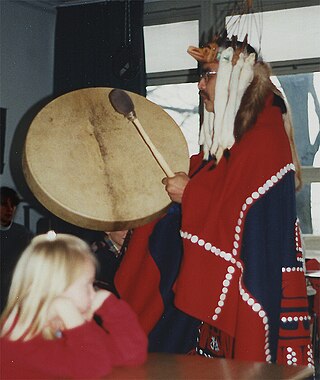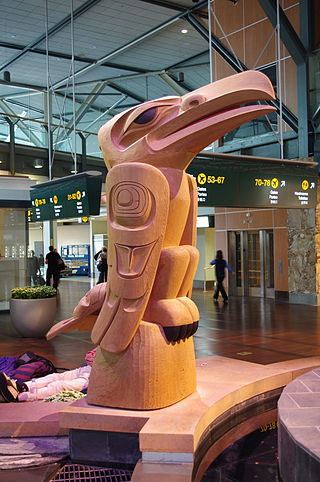Terry Starr is a Tsimshian Nation artist from the Gispaxlo'ots tribe of British Columbia, Canada.
Terry Starr is a Tsimshian Nation artist from the Gispaxlo'ots tribe of British Columbia, Canada.
Starr's mother was from Kitsumkalum of the Eagle Clan, and his father was from Lax Kw'alaams, or the town of Port Simpson of the Killerwhale clan. His predominant family crest is the Eagle on his mother's side, while his sub crest is the Killerwhale on his father's.
Alu'-Alums or 'Crying for or longing after something or someone' Starr was given this childhood name when he was six years old by the Chief of the Tribe when his grandfather died. Thla-enak or 'It's been a long time' - his adult name was given to him by the acting Chief when Starr returned to the village after a long absence.
Subsequent to completing a college business course in 1982, Starr purchased two adzes and three knives, his first carving tools. Tim Paul of the Nuu-chah-nulth Nation and Richard Hunt of the Kwakwaka’wakw people were among the first to influence Starr on the basic techniques of carving wood. Their ancestral styles greatly influence the artwork that he creates today. In 1984, he sat and learned carving techniques from Richard Hunt, master Kwagiulth artist at Thunderbird Park and the Royal British Columbia Museum in Victoria, British Columbia.
Starr is best known for his masks reflecting the traditional pigments and form lines of his ancestry. He usually paints only a portion of his masks to deliberately reveal the fluid grain of the wood. His pieces can be found in many local and international collections. For example, the Paul and Joan Gluck Collection of Native Arts contains more than 200 art pieces collected for more than 20 years and is considered one of the largest in the world. Starr was featured in an exhibit at one of the largest historical museums in the United States, the Historical Museum of Southern Florida. [1]
On two separate occasions Starr has been contracted to construct a full-scale replicas of a traditional Tsimshian bighouse. For both of these projects, he was responsible for hiring and training a crew of carvers. One was for the Canadian Museum of Civilization in Gatineau, Quebec, and the other was onsite at the Port Simpson village where he grew up.

Totem poles are monumental carvings found in western Canada and the northwestern United States. They are a type of Northwest Coast art, consisting of poles, posts or pillars, carved with symbols or figures. They are usually made from large trees, mostly western red cedar, by First Nations and Indigenous peoples of the Pacific Northwest Coast including northern Northwest Coast Haida, Tlingit, and Tsimshian communities in Southeast Alaska and British Columbia, Kwakwaka'wakw and Nuu-chah-nulth communities in southern British Columbia, and the Coast Salish communities in Washington and British Columbia.

The Kwakwa̱ka̱ʼwakw, also known as the Kwakiutl, are one of the indigenous peoples of the Pacific Northwest Coast. Their current population, according to a 2016 census, is 3,665. Most live in their traditional territory on northern Vancouver Island, nearby smaller islands including the Discovery Islands, and the adjacent British Columbia mainland. Some also live outside their homelands in urban areas such as Victoria and Vancouver. They are politically organized into 13 band governments.

The Tsimshian are an Indigenous people of the Pacific Northwest Coast. Their communities are mostly in coastal British Columbia in Terrace and Prince Rupert, and Metlakatla, Alaska on Annette Island, the only reservation in Alaska.
The Gispwudwada or Gisbutwada is the name for the Killerwhale "clan" (phratry) in the language of the Tsimshian nation of British Columbia, Canada, and southeast Alaska. It is considered analogous or identical to the Gisgahaast clan in British Columbia's Gitxsan nation and the Gisḵ'ahaast/Gisḵ'aast Tribe of the Nisg̱a'a. The Nisg̱a'a also call this group the Killerwhale Tribe, though the Gitxsan use the term Fireweed clan; Gisgahaast means literally "people of the fireweed."
The Laxsgiik is the name for the Eagle "clan" (phratry) in the language of the Tsimshian nation of British Columbia, Canada, and southeast Alaska. It is considered analogous or identical to identically named groups among the neighboring Gitksan and Nisga'a nations and also to lineages in the Haida nation.
The Kitkatla or Gitxaala are one of the 14 bands of the Tsimshian nation of the Canadian province of British Columbia, and inhabit a village, also called Kitkatla, on Dolphin Island, a small island just by Porcher Island off the coast of northern B.C. Because of their location, the Kitkatla have sometimes been called Porcher Island Indians. They were also, in the early contact period, called the Sebassa tribe, for their paramount chief at the time, Ts'ibasaa. The name Kitkatla derives from the Tsimshian name Gitkxaała, from git- and kxaała, since they are the farthest from the mainland of the Tsimshian tribes. Another name for themselves is Git lax m'oon in recognition of the land they lived on: the islands and inlets of this rugged piece of coastline.
Kitsumkalum is an original tribe/ galts'ap (community) of the Tsimshian Nation. Kitsumkalum is one of the 14 tribes of the Tsimshian nation in British Columbia, Canada. Kitsumkalum and is also the name of one of their Indian Reserve just west of the city of Terrace, British Columbia, where the Kitsumkalum River flows into the Skeena River. Archaeological evidence places Kitsumkalum with property holdings (laxyuup/territories) in the Kitsumkalum Valley, down the Skeena River to the coast, the Zymagotitz River, areas around Lakelse Lake and many special sites surrounding coastal and inland areas of the North West Coast prior to 1846 and as far back as 5,000 years BP.
Kitselas, Kitsalas or Gits'ilaasü are one of the 14 tribes of the Tsimshian nation of British Columbia, in northwestern Canada. The original name Gits'ilaasü means "people of the canyon." The tribe is situated at Kitselas, British Columbia, at the upper end of Kitselas Canyon, which is on the Skeena River. It was once a great trading nexus, just outside and upriver from the city of Terrace. It is the most upriver of the 14 tribes and it borders the territory of the Gitxsan nation.

Lax-Kwʼalaams, previously called Port Simpson until 1986, is an Indigenous village community in British Columbia, Canada, not far from the city of Prince Rupert. It is located on Port Simpson Indian Reserve No. 1, which is shared with other residential communities of the Tsimshian Nation. The Nine Allied Tribes are: Gilutsʼaaw, Ginadoiks, Ginaxangiik, Gispaxloʼots, Gitando, Gitlaan, Gitsʼiis, Gitwilgyoots, and Gitzaxłaał.
The Ginaxangiik are one of the 14 tribes of the Tsimshian nation in British Columbia, Canada, and one of the nine of those tribes making up the "Nine Tribes" of the lower Skeena River resident at Lax Kw'alaams, B.C. The name Ginaxangiik means literally "people of the hemlock." Their traditional territory includes the watershed of the Exchamsiks River, a tributary of the Skeena River. Since 1834, they have been based at Lax Kw'alaams, when a Hudson's Bay Company fort was established there.
The Gispaxlo'ots are one of the 14 tribes of the Tsimshian nation in British Columbia, Canada, and one of the nine of those tribes making up the "Nine Tribes" of the lower Skeena River resident at Lax Kw'alaams, B.C. The name Gispaxlo'ots means literally "people of the place of elderberries." Their traditional territory includes an area on the Skeena River between present-day Terrace and Prince Rupert. Since 1834, when a Hudson's Bay Company trading fort was established at Lax Kw'alaams, they have been based there. Their chief Ligeex permitted the HBC to build on Gispaxlo'ots territory.
The Gitando are the youngest of the 14 tribes of the Tsimshian people in British Columbia, Canada. It is one of the nine of those tribes making up the "Nine Tribes" First Nation of the lower Skeena River resident at Lax Kw'alaams, British Columbia. The name Gitando means the people of weirs. Their traditional territory includes the watershed of the Exstew River, a tributary of the Skeena River. Since 1834, the Gitando have been based at Lax Kw'alaams, following establishment of a Hudson's Bay Company trading fort there. They are closely related to the Gispaxlo'ots, another of the Nine Tribes, who have an adjacent territory.
The Gits'iis are one of the 14 tribes of the Tsimshian nation in British Columbia, Canada, and one of the nine of those tribes making up the "Nine Tribes" of the lower Skeena River resident at Lax Kw'alaams, B.C.
Frederick Alexcee was a Canadian carver and painter from the community of Lax Kw'alaams with Tsimshian ethnicity.

Dempsey Bob, OC D.Litt is a Northwest Coast woodcarver and sculptor from British Columbia, Canada, who is of Tahltan and Tlingit First Nations descent. He was born in the Tahltan village of Telegraph Creek on the Stikine River in northwestern B.C., and is of the Wolf clan.
Freda Diesing was a Haida woman of the Sadsugohilanes Clan, one of very few female carvers of Northwest Coast totem poles and a member of the Council of the Haida Nation of British Columbia, Canada. Her Haida name is Skil Kew Wat, meaning "magical little woman."
Ron Joseph Telek was a Canadian First Nations sculptor. He is a member of the Laxsgiik of the Nisga'a nation of northwestern British Columbia, and carries the hereditary name of Jagam Txalp meaning Four Canoes Coming into the Village. Telek's primary medium for his sculptures is wood, although he also includes other materials such as bone, moose hair and abalone into his work.

A transformation mask, also known as an opening mask, is a type of mask used by indigenous people of the Northwest Coast and Alaska in ritual dances. These masks usually depict an outer, animal visage, which the performer can open by pulling a string to reveal an inner human face carved in wood to symbolize the wearer moving from the natural world to a supernatural realm. Northwest coast peoples generally use them in potlatches to illustrate myths, while they are used by Alaska natives for shamanic rituals.

Beau Dick was a Kwakwaka'wakw Northwest Coast artist and Chief who lived and worked in Alert Bay, British Columbia, Canada. He was a contemporary artist, activist and hereditary Chief from the Namgis First Nation. Dick was an award winning artist with an extensive national and international exhibition history.
Phil Gray is a Canadian artist who specializes in wood carvings from the Tsimshian and Mikisew Cree communities. His work uses traditional technique and features imagery from legends. In 2014, Gray was awarded a British Columbia Creative Achievement Award in Aboriginal Art from the Government of British Columbia.